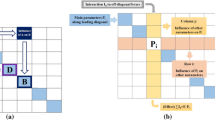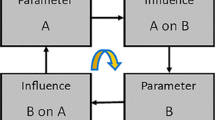Abstract
Drilling and blasting is the predominant excavation method of the tunnels driven in hard rock. Overbreak is an undesirable outcome of blasting operation that has a profound effect on the safety and cost of tunnels. Determination of overbreak and the corresponding risk is of vital importance. The main aim of this research has therefore been to assess the risk associated with overbreak as well as its prediction. To do this, a rock engineering system (RES) based model has been proposed. The research data in this study was drawn from four tunnels located in Bakhtiari dam project, Iran. For 54 blasting operations carried out in the investigated tunnels, the values of 14 causative factors in overbreak were carefully measured. The result of this study shows that the developed RES based model with a high value of coefficient of determination (R2 = 0.91) is a reliable technique to predict overbreak. Furthermore, the evidence from this study suggests that the Tunneling Rock Quality Index, perimeter specific charge and burden to spacing ratio play a large part in the values of overbreak. From the risk assessment conducted for the investigated tunnels, no blast operation was found to be highly problematic. Also, the overall risk level posed by overbreak was in medium range where the overbreak might be slightly problematic, and need to be monitored. The newly suggested RES model is also evaluated using 8 blasting operations, showing high level of performance.











Similar content being viewed by others
References
Ali KM, Hasan K (2002) Rock mass characterization to indicate slope instability at Bandarban, Bangladesh: a rock engineering systems approach. Environ Eng Geosci 8(2):105–119
Andriani GF, Parise M (2017) Applying rock mass classifications to carbonate rocks for engineering purposes with a new approach using the rock engineering system. J Rock Mech Geotech Eng 9(2):364–369
Barton N (1974) Engineering classification of rock masses for the design of tunnel support. Rock Mech 6:189
Benardos AG, Kaliampakos DC (2004) A methodology for assessing geotechnical hazards for TBM tunneling illustrated by the Athens Metro, Greece. Int J Rock Mech Min Sci 41:987–999
Bieniawski Z (1973) Engineering classification of jointed rock masses. Civ Eng S Afr 15(12):335–343
Brady BHG, Brown ET (1985) Rock mechanics for underground mining. George Allen & Unwin, Sydney
Cancelli A, Crosta G (1993) Hazard and risk assessment in rockfall prone areas. In: Skipp B (ed) Risk and reliability in ground engineering. Thomas Telford, London, pp 177–190
Chakraborty AK, Roy PP, Jethwa L, Gupta RN (1998) Blast performance in small tunnels—a critical evaluation in underground metal mines. Tunn Undergr Space Technol 13(3):331–339
Chakraborty AK, Raina AK, Ramulu M, Choudhury PB, Haldar A, Sahoo P, Bandopadhy C (2004) Development of rational models for tunnel blast prediction based on a parametric study. Geotech Geol Eng 22:477–496
Dey K, Murthy VMSR (2012) Prediction of blast-induced overbreak from uncontrolled burn-cut blasting in tunnels driven through medium rock class. Tunn Undergr Space Technol 28:49–56
Faramarzi F, Ebrahimi Farsangi MA, Mansouri H (2013) An RES based model for risk assessment and prediction of back break in bench blasting. Rock Mech Rock Eng 46:877–887
Faramarzi F, Mansouri H, Ebrahimi Farsangi MA (2014) Development of rock engineering systems-based models for fly rock risk analysis and prediction of flyrock distance in surface blasting. Rock Mech Rock Eng 47:1291–1306
Franklin JA, Ibarra JA, Maerz NH (1989) Blast overbreak measurement by light sectioning. Int J Min Geol Eng 7(4):323–331
Hasanipanah M, Jahed Armaghani D, Monjezi M, Shams S (2016) Risk assessment and prediction of rock fragmentation produced by blasting operation: a rock engineering system. Environ Earth Sci. https://doi.org/10.1007/s12665-016-5503-y
Hoek E, Brow ET (1980) Underground excavations in rock. The Institution of Mining and Metallurgy, London
Hudson JA (1992) Rock engineering systems: theory and practice. Ellis Horwood, Chichester
Ibarra JA, Maerz NH, Franklin JA (1996) Overbreak and underbreak in underground openings part 2: causes and implications. Geotech Geol Eng 14:325–340
Jang H, Topal E (2013) Optimizing overbreak prediction based on geological parameters comparing multiple regression analysis and artificial neural network. Tunn Undergr Space Technol 38:161–169
Kim Y, Moon HK (2013) Application of the guideline for overbreak control in granitic rock masses in Korean tunnels. Tunn Undergr Space Technol 35:67–77
Koehler M, Carey J (2002) Blasting techniques to control roof failure in underground Limestone mine. In: Proceedings of the 28th conference on explosives and blasting techniques, February, Las Vegas, pp 91–102
Latham JP, Lu P (1999) Development of an assessment system for the blastability of rock masses. Int J Rock Mech Min Sci 36:41–55
Lu P, Hudson JA (1993) A fuzzy evaluation approach to the stability of underground excavations. In: Proceedings of the ISRM symposium: EUROCK’93, pp 615–622
Mandal SK, Singh MM (2008) Evaluating extent and causes of overbreak in tunnels. Tunn Undergr Space Technol 24:22–36
Martin CD, Kaiser PK Alcott JM (1996) Predicting the depth of stress-induced failure around underground openings. In: Proceedings of 49th Canadian geotechnical conference, St. John’s, C-CORE, vol 1, pp 105–114
Mazzoccola D, Hudson JA (1996) A comprehensive method of rock mass characterization for indicating natural slope instability. Q J Eng Geol Hydrogeol 29:37–56
McKown A (1984) Some aspects of design and evaluation of perimeter controlled blasting in fractured and weathered rock. In: 10th conference on explosive and blasting techniques, January 28–February 2, Orlando, Florida, pp 120–152
Mohammadi M, Farouq MH, Mirzapour B, Hajiantilaki N (2015) Use of fuzzy logic for minimizing overbreak in underground blasting operations: a case study of Alborz Tunnel, Iran. Int J Min Sci Technol 25(3):439–445
Mohammadi H, Barati B, Yazdani Chamzini A (2017) Prediction of blast-induced overbreak based on geo-mechanical parameters, blasting factors and the area of tunnel face. Geotech Geol Eng. https://doi.org/10.1007/s10706-017-0336-3
Mottahedi A, Sereshki F, Ataei M (2018) Development of overbreak prediction models in drill and blast Tunneling using soft computing methods. Eng Comput. https://doi.org/10.1007/s00366-017-0520-3
Murthy VMSR, Dey K, Raitani R (2003) Prediction of overbreak in underground tunnel blasting a case study. J Can Tunn Can 109–115
Singh SP (1997) Cost effective blast damage control with tracer blasting. Miner Resour Eng J 6(2):49–61
Singh SP (1998) The effects of rock mass characteristics on blast hole deviation. CIM Bull 91(1016):90–95
Singh SP, Xavier P (2005) Causes, impact and control of overbreak in underground excavations. Tunn Undergr Space Technol 20:63–71
Terzaghi K, Proctor RV, White TL (1946) Rock tunneling with steel supports. The commercial Shearing and Stamping Co., pp 17–99
Author information
Authors and Affiliations
Corresponding author
Additional information
Publisher's Note
Springer Nature remains neutral with regard to jurisdictional claims in published maps and institutional affiliations.
Rights and permissions
About this article
Cite this article
Mohammadi, H., Azad, A. Applying Rock Engineering Systems Approach for Prediction of Overbreak Produced in Tunnels Driven in Hard Rock. Geotech Geol Eng 38, 2447–2463 (2020). https://doi.org/10.1007/s10706-019-01161-z
Received:
Accepted:
Published:
Issue Date:
DOI: https://doi.org/10.1007/s10706-019-01161-z




